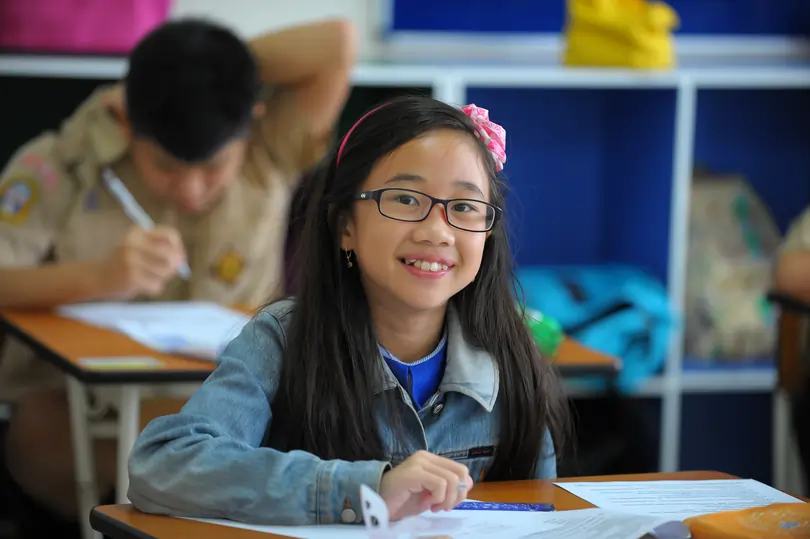Whole Numbers 3
In this article, the learning objectives are:
- Whole Number Strategy – Grouping
Whole Number Strategy – Grouping
In Whole Number Strategy – Grouping, we will solve questions by grouping the items in a group and determine the number of groups involved.
Question 1:
\(3\) apples cost \($5\). What is the cost of \(9\) apples?
Solution:
Number of apples in 1 group \(= 3\) apples
Number of groups of apples\(\begin{align}\\ &= 9 \div 3\\ &= 3 \end{align}\)
Cost of 1 group of apples \(= $5\)
Cost of 3 groups of apples\(\begin{align}\\ &= 3 \times $5\\ &= $15 \end{align}\)
The cost of \(9\) apples is \($15\).
Answer:
\($15\)
Question 2:
A fruit seller sold \(5\) mangoes for \($8\). Marissa bought \(25\) mangoes from the fruit seller. How much did she pay?
Solution:
Number of mangoes in 1 group \(= 5\) mangoes
Number of groups of mangoes\(\begin{align}\\ &= 25 \div 5\\ &= 5 \end{align}\)
Cost of 1 group of mangoes \(= $8\)
Cost of 5 group of mangoes\(\begin{align}\\ &= 5 \times $8\\ &= $40 \end{align}\)
She paid \($40\).
Answer:
\($40\)
Question 3:
At a supermarket, every \(5\) apples cost \($2\) and every \(10\) oranges cost \($3\). Find the total cost of \(10\) apples and \(30\) oranges.
Solution:
Number of apples in 1 group \(= 5\) apples
Number of groups of apples\(\begin{align}\\ &= 10 \div 5\\ &= 2 \end{align} \)
Cost of 1 group of apples \(= $2\)
Cost of 2 groups of apples\(\begin{align}\\ &= 2 \times $2\\ &= $4 \end{align}\)
Number of oranges in 1 group \(= 10\) oranges
Number of groups of oranges\(\begin{align}\\ &= 30 \div 10\\ &= 3 \end{align}\)
Cost of 1 group of oranges \(= $3\)
Cost of 3 groups of oranges\(\begin{align}\\ &= 3 \times $3\\ &= $9 \end{align}\)
Total cost of \(10\) apples and \(30\) oranges\(\begin{align}\\ &= $4 + $9\\ &= $13 \end{align}\)
The total cost of \(10\) apples and \(30\) oranges is \($13\).
Answer:
\($13\)
Question 4:
Ahmad painted \(30\) balls using either green or red paint. For every \(4\) balls painted green, \(2\) balls were painted red. How many balls were painted red?
Solution:
There are \(4\) green balls and \(2\) red balls red in 1 group.
Number of groups of balls\(\begin{align}\\ &= 30 \div 6\\ &= 5 \end{align}\)
Number of balls painted red in 1 group \(= 2\)
Number of red balls in 5 groups\(\begin{align}\\ &= 5 \times 2\\ &= 10 \end{align}\)
\(10\) balls were painted red.
Answer:
\(10\) balls
Question 5:
Yvonne received \(3\) free packets of milk for every \(5\) packets of biscuits she bought. Given that she received \(27\) free packets of milk, how many packets of biscuits did she buy?
Solution:
There are \(5\) packets of biscuits and \(3\) free packets of milk in 1 group.
Number of groups\(\begin{align}\\ &= 27 \div 3\\ &= 9 \end{align}\)
Number of packets of biscuits in 1 group \(= 5\)
Number of packets of biscuits in 9 groups\(\begin{align}\\ &= 9 \times 5\\ &= 45 \end{align}\)
She bought \(45\) packets of biscuits.
Answer:
\(45\) packets
Question 6:
Helen received \(3\) bonus stamps for every \($5\) she spent in a supermarket. Given that she spent a total of \($189\), how many bonus stamps will she get?
Solution:
Number of groups of \($5\) in \(\begin{align}\\ $189 &= $189 \div $5\\ &= 37 \text{ groups R } $4 \end{align}\)
There are \(37\) groups of \($5\) and a remainder of \($4\).
Number of bonus stamps she will get\(\begin{align}\\ &= 37 \times 3\\ &= 111 \end{align}\)
She will get \(111\) bonus stamps.
Answer:
\(111\) cookies
Question 7:
Pauline baked \(498\) cookies to sell. She packed the cookies into boxes of 8 and sold each box for \($7\). If she sold all the boxes of cookies, how much money did she collect?
Solution:
Number of boxes of \(8\) cookies\(\begin{align}\\ &= 498 \div 8\\ &= 62 \text{ groups R 2 cookies} \end{align}\)
She packed \(62\) boxes of \(8\) cookies and there are \(2\) cookies left.
Amount of money she collected\(\begin{align}\\ &= 62 \times $7\\ &= $434 \end{align}\)
She collected \($434\).
Answer:
\($434\)
Question 8:
During a sale, notebooks were sold at \(5\) for \($7\). Given that Janice has \($50\), what is the greatest number of notebooks she could buy?
Solution:
Number of groups of \($7\) in \(\begin{align}\\ $50 &= $50 \div $7\\ &= 7 \text{ groups R } $1 \end{align}\)
There are \(7\) groups of \($7\) and a remainder of \($1\).
Greatest number of notebooks she could buy\(\begin{align}\\ &= 7 \times 5\\ &= 35 \end{align}\)
The greatest number of notebooks she could buy is \(35\).
Answer:
\(35\)
Question 9:
Tom has \($20\). He wants to buy as many pens as he can. A pen costs \($2\) while a pack of \(5\) pens costs \($8\). What is the greatest number of pens he could buy?
Solution:
Number of pens in 1 group \(= 5\) pens
Cost of 1 group of pens \(= $8\)
Number of groups of \($8\) in \(\begin{align}\\ $20 &= $20 \div $8\\ &= 2 \text{ groups R } $4 \end{align}\)
There are 2 groups of \($8\) and a remainder of \($4\).
Number of pens in 2 groups\(\begin{align}\\ &= 2 \times 5\\ &= 10 \end{align}\)
Cost of 1 pen \(= $2\)
Number of pens Tom can buy with the remaining \(\begin{align}\\ $4 &= $4 \div $2\\ &= 2 \end{align}\)
Greatest number of pens Tom could buy\(\begin{align}\\ &= 10 + 2\\ &= 12 \end{align}\)
The greatest number of pens Tom could buy is \(12\).
Answer:
\(12\)
Question 10:
A fruit seller bought \(17\) boxes of mangoes. Each box contained \(5\) mangoes. He repacked the mangoes into packets of \(3\) and sold all the packets at \($10\) each. How much money did he collect?
Solution:
Total number of mangoes\(\begin{align}\\ &= 17 \times 5\\ &= 85 \end{align}\)
Number of packets of \(3\) mangoes\(\begin{align}\\ &= 85 \div 3\\ &= 28 \text{ groups R } 1 \text{ mango} \end{align}\)
The fruit seller packed \(28\) packets of \(3\) mangoes and had \(1\) mango left.
Cost of 1 packet of mangoes \(= $10 \)
Amount of money he collected from \(28\) packets of mangoes\(\begin{align}\\ &= 28 \times $10\\ &= $280 \end{align}\)
He collected \($280\) from his sale.
Answer:
\($280\)
Question 11:
The following shows the ongoing promotion for T-shirts at a store.
Terry wants to get \(12\) T-shirts. What is the least amount of money he has to pay?
Solution:
Number of T-shirts in 1 group\(\begin{align}\\ &= 2 + 1\\ &= 3 \end{align}\)
Number of groups of 3 T-shirts\(\begin{align}\\ &= 12 \div 3\\ &= 4 \end{align}\)
Cost of 1 group of T-shirts\(\begin{align}\\ &= 2 \times $45\\ &= $90 \end{align}\)
Cost of 4 groups of T-shirts\(\begin{align}\\ &= 4 \times $90\\ &= $360 \end{align}\)
The least amount he has to pay is \($360\).
Answer:
\($360\)
Question 12:
The following shows the ongoing promotion for scarves at a store.
Violet wants to buy \(11\) scarves. What is the least amount of money she has to pay?
Solution:
Number of scarves in 1 group\(\begin{align}\\ &= 3 + 1\\ &= 4 \end{align}\)
Number of groups of 4 scarves\(\begin{align}\\ &= 11 \div 4\\ &= 2 \text{ groups R } 3 \text{ scarves} \end{align}\)
To get \(11\) scarves, there are 2 groups of \(4\) scarves and another \(3\) scarves.
Number of free scarf in 1 group \(= 1\)
Number of free scarves in 2 groups\(\begin{align}\\ &= 2 \times 1\\ &= 2 \end{align} \)
Number of scarves paid for\(\begin{align}\\ &= 11-2\\ &= 9 \end{align}\)
Total amount of money Violet need to pay\(\begin{align}\\ &= 9 \times $22.50\\ &= $202.50 \end{align}\)
Violet needs to pay \($202.50\).
Answer:
\($202.50\)
Question 13:
Gary bought doughnuts at Shop A. Aziz spent the same amount of money as Gary at Shop B. How many doughnuts did Aziz buy at Shop B?
Solution:
Gary (Shop A):
Number of doughnuts in 1 group \(= 3\)
Number of groups of doughnuts Gary bought\(\begin{align}\\ &= 15 \div 3\\ &= 5 \end{align}\)
Cost of 1 group of doughnuts \(= $2\)
Cost of 5 groups of doughnuts\(\begin{align}\\ &= 5 \times $2\\ &= $10 \end{align} \)
Since Aziz spent the same amount of money as Gary, Aziz spent \($10\) on doughnuts at Shop B.
Aziz (Shop B):
Number of groups of \($5\) in \(\begin{align}\\ $10 &= $10 \div $5\\ &= 2 \end{align}\)
Number of doughnuts in 1 group \(= 6\)
Number of doughnuts in 2 groups\(\begin{align}\\ &= 2 \times 6\\ &= 12 \end{align}\)
Aziz bought doughnuts at Shop B.
Answer:
12 doughnuts
 SG
SG  VN
VN 











